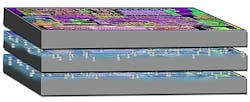IBM researchers to design liquid cooling directly into microchip designs and packaging
IBM won a $5 million contract last Thursday from the U.S. Defense Advanced Research Projects Agency (DARPA) in Arlington, Va., for the Intrachip/Interchip Enhanced Cooling (ICECool) Fundamentals program, which is the first step in the DARPA ICECool program, and will develop the fundamental building blocks of intra- and interchip evaporative microfluidic cooling.
IBM microelectronics thermal management experts will explore revolutionary new thermal-management technologies for military electronics to help designers make substantial reductions in size, weight, and power consumption (SWaP).
DARPA scientists are asking IBM to find ways to shrink chip-cooling technologies such that they can build cooling into the chip itself. The goal is to close the gap between chip and chip-cooling technologies for military electronics like computers, RF transceivers, and solid-state lasers.
IBM leads the first of what eventually may involve several industry teams working on different substrates and on different thermal-management approaches. Resulting technologies are expected to feed into future efforts within the ICECool thermal management program.
While IBM researchers are handling the first phase of the DARPA ICECool program, which is to develop fundamental technological building blocks for on-chip built-in liquid cooling, DARPA released a formal solicitation last February for the next phase ICECool program phase.
The February solicitation involves the ICECool Applications program, which seeks to demonstrate advanced electronics cooling techniques for high-performance embedded computing (HPEC) and RF monolithic microwave integrated circuit (MMIC) power amplifiers with convective or evaporative microfluidic cooling built directly into the electronic devices and packaging.
The first ICECool Fundamentals solicitation went out to industry in June 2012, and IBM is the first company involved in this phase. No contracts for the next phase, ICECool Applications, have been awarded yet.
In the first phase of the DARPA ICECool program IBM researchers will try to alleviate cooling limitations of advanced military electronics by integrating thermal management techniques into the chip layout, substrate structure, and package design, not only to shrink on-chip cooling, but also to enhance overall electronics performance.
Essentially, IBM experts are seeking to make cooling just as important as any other aspect of chip design, and use embedded thermal management to enhance the performance of military electronics. Integrating chips with convective or evaporative microfluidic cooling, DARPA officials say, has the potential to speed the evolution of advanced chip integration, DARPA officials say.
Specifically, IBM researchers will try to demonstrate chip-level heat removal in excess of 1 kilowatt per square centimeter heat flux, as well as 1 kilowatt per cubic centimeter heat density with thermal control of local submillimeter hot spots with heat flux exceeding 5 kilowatts per square centimeter.
IBM will develop microfabrication techniques over two or three years to implement thermal interconnects and evaporative microfluidics in several microchanneled semiconductor chips. DARPA also may as IBM to model intrachip cooling with evaporative flows in microchannel flow loops -- either within the chips themselves, or in the microgaps between chips in 3D chip stacks.
This causes some advanced electronics to perform well below the inherent electrical limits of the device technology. Integrating cooling directly into the chip could transform electronic systems architectures and overcome the SWaP bottleneck in advanced electronics, DARPA officials say.
The ICECool program will complement other DARPA thermal-management initiatives, such as the Thermal Ground Plane (TGP) program to develop modern high-performance heat spreaders to replace the copper alloy spreaders in conventional systems; the Microtechnologies for Air Cooled Exchangers (MACE) program to develop enhanced heatsinks that reduce the thermal resistance and power requirements for cooling fans; and the Active Cooling Module (ACM) program to develop miniature, active, high-efficiency refrigeration systems based on thermoelectric or vapor-compression technologies.
For more information contact the DARPA Microelectronics Technology Office (MTO) online at www.darpa.mil/Our_Work/MTO, or IBM at www.ibm.com.

